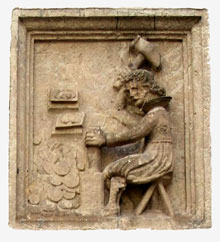
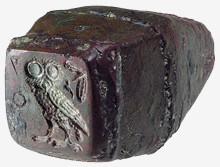
5th Century BC Athenian Owl Tetradrachm Iron Die
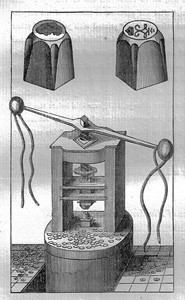
17th Century Screw Press for Milled Coins
An alternative method of producing early coins, particularly found in Asia, especially in China, was to cast coins using molds. This method of coin production began in 4th century China, spreading to Southeast Asia and Japan, and casting in this region continued all the way into the 19th century. Up to a couple of dozen coins could be produced at one time from a single mold, when a 'tree' of coins, which often contained features such as a square hole in the center, would be produced and the individual coins, called cash, would then be broken off.
The History of Ancient Greek coinage can be divided into three periods, the Archaic, the Classical, and the Hellenistic. The Archaic period extends from the introduction of coinage to the Greek world in about 600 BC until the Persian Wars in about 480 BC. The Classical period then began, and lasted until the conquests of Alexander the Great in about 330 BC, which began the Hellenistic period, extending until the Roman absorption of the Greek world in the 1st century BC. The Greek cities continued to produce their own coins for several more centuries under Roman rule, called Roman provincial coins.
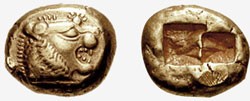
Lion electrum coin from Lydia 6th century BC
The Greek world at this time was divided into more than two thousand self-governing city-states and more than half of them issued their own coins. Some coins circulated widely beyond their areas, indicating that they were being used in inter-city trade. The first example appears to have been the silver stater of Aegina minted circa 700-550 BC and they depicted a sea turtle. These coins regularly turn up in hoards in Egypt or the Levant, which were deficient in their own supplies of silver. As such coins circulated more widely, coins of other cities came increasingly to be minted to the same weight standard (the weight standard of the Aegina drachm was 6.1g), although marked with the symbols of the issuing city. This is not unlike present day Euro coins, which are recognizably from a particular country, but usable all over the Euro zone.
Athenian coins, however, were struck on the "Attic" standard, with a drachm of 4.3g. Over time, Athens' plentiful supply of silver from the mines at Laurion and its increasing dominance in trade made this the pre-eminent standard. Tetradrachms (equal to four drachms) on this weight standard continued to be a widely used coin through the classical period. Alexander the Great and the Hellenistic monarchs needed the large denomination coins to make large payments and they were also easier to hoard. The word drachm means "a handful." Drachms could be divided into six obols (from the Greek word for a spit of iron), and six "spits" made a handful. This suggests that before coinage came to be used in Greece, roasting spits were used as measures of value, perhaps for paying fines.
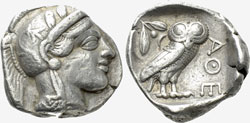
Athena & Owl tetradrachm
of Athens 454 - 404 BC
The use of coins for propaganda purposes was a Greek invention. Coins are valuable, durable and pass through many hands. In an age without newspapers or other mass media, they were an ideal way of disseminating a political message. The first such coin was a commemorative decadrachm issued by Athens following the Greek victory in the Persian Wars. On these coins the owl of Athens was depicted facing the viewer with wings outstretched, holding a spray of olive leaves. The message was that Athens was powerful and victorious, but peace-loving.
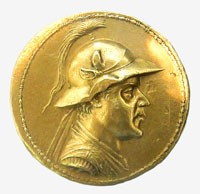
Gold 20-stater of Eucratides I.
The largest gold coin ever
minted in Antiquity.
Still, some of the Greco-Bactrian coins and those of their successors in India, the Indo-Greeks, are considered the finest examples of Greek numismatic art with a nice blend of realism and idealization. These included the largest coins to be minted in the Hellenistic world: the largest gold coin was minted by Eucratides (reigned 171-145 BC), the largest silver coin by the Indo-Greek king Amyntas (reigned c. 95-90 BC). The portraits show a degree of individuality never matched by the often bland depictions of their royal contemporaries further west.
The most striking new feature of Hellenistic coins was the use of portraits of living people, namely of the kings themselves. This practice had begun in Sicily, but was disapproved of by other Greeks as showing hubris (pride). But the kings of Ptolemaic Egypt and Seleucid Syria had no such scruples and issued magnificent gold coins adorned with their own portraits, with the symbols of their state on the reverse. The names of the kings were frequently inscribed on the coin as well. This established a pattern for coins which has persisted ever since: a portrait of the king, usually in profile and striking a heroic pose on the obverse with his name beside him and a coat of arms or other symbol of state on the reverse.
Of all the things that have survived the passage of time between ancient Greece and today, the Greek myths are probably the most enduring. The Ancient Greek people recognized 14 major gods and goddesses: Zeus, Poseidon, Hades, Apollo, Artemis, Aphrodite, Ares, Dionysus, Hephaestus, Athena, Hermes, Demeter, Hestia, and Hera. Different cities worshipped different deities, sometimes with epithets that specified their local nature. The religious practices of the Greeks extended beyond mainland Greece, to the islands and coasts of Ionia in Asia Minor, to Magna Graecia (Sicily and southern Italy), and to scattered Greek colonies in the Western Mediterranean. Greek religion was also the bases that formed much of the later Ancient Roman religion.
The gods acted like humans, and had human vices. They would interact with humans, sometimes even spawning children with them. At times certain gods would be opposed to another, and they would try to outdo each other. In the Iliad, for example, Zeus, Aphrodite, Ares and Apollo support the Trojan side in the Trojan War, while Hera, Athena and Poseidon support the Greeks.
Some gods were specifically associated with a certain city. For instance, Athena was associated with the city of Athens, Apollo with Delphi, Zeus with Olympia and Aphrodite with Corinth. Other deities were associated with nations outside of Greece, for instance Poseidon was associated with Ethiopia and Troy, and Ares with Thrace. Though the worship of the major deities spread from one locality to another, and though most larger cities boasted temples to several major gods, the identification of different gods with different places remained strong to the end.
The Greeks believed in an underworld where the spirits of the dead went to after their death. If a funeral was never performed, it was commonly believed that that person's spirit would never reach the underworld and so would haunt the world as a ghost forever. One of the most widespread areas of the underworld was known as Hades. This was ruled over by a god, also called Hades. Another realm, called Tartarus, was the place where the damned were thought to go, a place of torment. A third realm, Elysium, was a pleasant place where the virtuous dead and initiates in the mystery cults were said to dwell. A very few, like Achilles and a great part of those who fought in the Trojan and Theban wars, were considered to have been physically immortalized and brought to live forever in Elysium, the islands of the blessed heaven, the ocean literally right under the ground.
Greek religion consisted largely of stories of the gods and of how they affected humans on Earth. Myths often revolved around heroes and their actions, such as Heracles and his twelve labors, Odysseus and his voyage home, Jason and the quest for the Golden Fleece and Theseus and the Minotaur. Many different species existed in Greek mythology. Chief among these were the gods and humans, though the Titans also heavily appeared in Greek myths. They predated the Olympian gods and were hated by them. Lesser species included the half-man, half-horse centaurs, the nature based nymphs and the half man, half goat satyrs. Some creatures in Greek mythology were monstrous, such as the one-eyed giant Cyclopes, the sea beast Scylla, Gorgons, and the half-man, half-bull Minotaur. Many of the myths revolved around the Trojan War between Greece and Troy. For instance, the epic poem, The Illiad, by Homer, is based around the war. Many other tales are based around the aftermath of the war, such as the adventures of Odysseus on his return to Ithaca.
The mythology largely survived and was added to in order to form the later Roman mythology. The Greeks and Romans had been literate societies and much mythology was written down in the forms of epic poetry, such as The Iliad and The Odyssey. Various religious festivals were held in ancient Greece. Many were specific only to a particular deity or city-state. For example, the festival of Lycaea was celebrated in Arcadia in Greece, which was dedicated to the pastoral god Pan. There were also the Olympic Games, which were held every four years, to celebrate the gods.
One of the most important moral concepts to the Greeks was a fear of committing hubris, which constituted many things, from rape to desecration of a corpse. It was a crime in the city-state of Athens. In the Odyssey hubris was Odysseus' pride. Although Pride and vanity were not considered sins themselves, the Greeks put emphasis on moderation. Pride only became a hubris when it went to extremes, like any other vice. The same was thought of drinking, eating-- anything done to excess was not considered proper. Ancient Greeks placed, for example, importance on athletics and intellect equally. In fact many of their competitions included both. Pride wasn't bad until it became all consuming and/or hurt people.
 Often temples were built to the gods. Some of the grandest and most notable were the Temple of Zeus at Olympia, and the Parthenon, dedicated to the goddess Athena upon the Acropolis in Athens. At some of these temples would be located an oracle who could predict the future. The most notable example was the Delphic oracle, whom was located at the Temple of Apollo at Delphi.
Often temples were built to the gods. Some of the grandest and most notable were the Temple of Zeus at Olympia, and the Parthenon, dedicated to the goddess Athena upon the Acropolis in Athens. At some of these temples would be located an oracle who could predict the future. The most notable example was the Delphic oracle, whom was located at the Temple of Apollo at Delphi.
Greek mythology has exerted an extensive influence on the culture, the arts and the literature of Western civilization and remains part of Western heritage and language. Poets and artists from ancient times to the present have derived inspiration from Greek mythology and have discovered contemporary significance and relevance in these mythological themes.
The Romans adopted gods and goddesses that were very similar with the same attributions as the Greek gods and goddesses, however, they had different names.
The Roman currency during most of the Roman Republic and the western half of the Roman Empire consisted of coins including the aureus (gold), the denarius (silver) and the sestertius and dupondius (bronze). These were used from the middle of the third century BC until the middle of the third century A.D. Unlike most modern coins, Roman coins had intrinsic value. While they contained precious metals, the value of a coin was higher than its precious metal content, so they were not bullion. Estimates of the value of the denarius range from 1.6 to 2.85 times its metal content, thought to equal the purchasing power of $15 at the beginning of the Roman Empire to around $29 by its end (comparing bread, wine and meat prices). One denarius was around one to three days' pay for a Legionnaire.
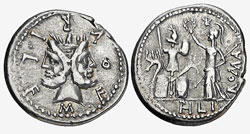
Janus & Roma denarius 120 BC
Imagery on the earliest denarii usually consisted of the bust of Roma on the obverse, and a deity driving a biga or quadriga (chariot) on the reverse. There was no mention of the moneyer's name, although occasionally coins featured control marks such as small symbols, letters, or monograms which might have been used to indicate who was responsible for a particular coin. Eventually, monograms and other symbols were replaced with abbreviated forms of the moneyer's name. After the addition of their names, moneyers began to use the coins to display images that relate of their family history. While not every coin issued featured references to an ancestor of a moneyer, the number of references increased and the depictions became more and more of current interest. Self-promoting imagery on coins was part of the increasing competition amongst the ruling class in the Roman Republic. The imagery on Republican coins wasn't meant to influence the populace; the messages were designed for and by the elite.
The imagery on coins took an important step when Julius Caesar issued coins bearing his own portrait. While moneyers had earlier issued coins with portraits of ancestors, Caesar's was the first Roman coinage to feature the portrait of a living individual. The tradition of putting one's own portrait on coinage was not abandoned following the assassination of Caesar, although the imperators from time to time also produced coins featuring the traditional deities and personifications found on earlier coins. The image of the Roman emperor took on a special importance in the centuries that followed, because during the empire, the emperor embodied the state and its policies.
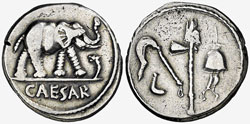
Julius Caesar elephant denarius 49 BC
Coins were an important means of disseminating this image throughout the empire. Coins often attempted to make the emperor appear god-like through associating the emperor with attributes normally seen in divinities, or emphasizing the special relationship between the emperor and a particular deity by producing a preponderance of coins depicting that deity. During his campaign against Pompey, Caesar issued a variety of types that featured images of either Venus or Aeneas, attempting to associate himself with his divine ancestors. Predecessors, and other family members, such as empresses, were also featured on the obverse of coins. To aid succession, the legitimacy of an heir was affirmed by producing coins for that successor. This was done from the time of Augustus till the end of the empire.
The silver denarius remained the backbone of the Roman economy from its introduction in 211 BC until it ceased to be normally minted in the middle of the third century. During this period, the purity and weight of the coin slowly, but inexorably decreased. The problem of debasement in the Roman economy appears to be pervasive, although the severity of the debasement often paralleled the strength or weakness of the Empire. The exact reason that Roman coinage sustained constant debasement is not known, but the most common theories involve inflation, trade with India, which drained silver from the Mediterranean world, and inadequacies in state finances. Another reason for debasement was lack of raw metal with which to produce coins.
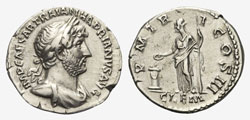
Emperor Hadrian denarius AD 124
Italy itself contains no large or reliable mines for precious metals; therefore the precious metals for coinage had to be obtained elsewhere. The majority of the precious metals that Rome obtained during its period of expansion arrived in the form of war booty from defeated territories, and subsequent tribute and taxes by new-conquered lands. When Rome ceased to expand, the precious metals for coinage then came from newly mined silver, such as from Greece and Spain, and from melting older coins. Without a constant influx of precious metals from an outside source, and with the expense of continual wars, it would seem reasonable that coins might be debased to increase the amount that the government could spend. A simpler possible explanation for the debasement of coinage is that it allowed the state to spend more than it had. By decreasing the amount of silver in their coins, Rome could produce more coins and "stretch" their budget. As time progressed, the trade deficit of the western empire (because of its buying of grain and other commodities) led to a currency drainage in Rome.
From the 16th to 18th centuries, "Cob" coins, also known as Macuquinas, were minted and used heavily in the territories of the New World. Cobs are the original "Treasure Coins" sought after by pirates and the inspiration for tales of buried treasure. The term "cob" comes from the Spanish phrase cabo de barra, which means from the end of a bar. The Spanish used very fine silver with purity ranging from 92% to 98%. The gold escudo coins were decreed by King Charles I to be 22 karats. Each coin was struck and trimmed by hand in the 1500s through 1700s at Spanish mints in Mexico, Peru, and Colombia (among others). Silver and gold cobs are handsomely crude, nearly all with a cross as the central feature on one side and either a coat-of-arms (shield) or a tic-tac-toe-like "pillars and waves" on the other side. Silver cobs are known as "reales" and gold cobs are known as "escudos", with two 8 reales (about 27 grams each) equaling one escudo. The wage for a common worker in the 17th century was approximately one 8 reales per month.
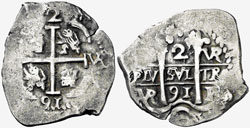
1691 Charles II 2 reales Potosi mint
Silver cobs were minted in denominations of 1/2, 1, 2, 4, and 8-reales and gold cobs were minted in denominations of 1, 2, 4, and 8 escudos. Some cobs were struck with a date, and most show a mintmark and an initial or monogram for the assayer, the mint official who was responsible for weight and fineness. The cross side (Florenzada, Greek or Jerusalem cross) featured two lions for Leon and two castles for Castile symbolizing the unification of Spain. The cross also symbolized the union of church and state and was a statement that Spain was the most powerful Catholic nation in the world.
The reverse side of the early type cobs pre-1652, featured the great Hapsburg shield Coat of Arms for the ruling monarch at the time of minting. The coat of arms of each Monarch would change due to wars, treaties and marriages and are now used to identify and date cob coins without inscribed dates. After 1652, the reverse side of the later Peru cob coins were dated and depict the imaginary Pillars of Hercules at the Straights of Gibraltar, with the letters PLV-SVL-TRA, which stands for plus ultra or "more beyond". Spain was stating that they controlled most of the New World.
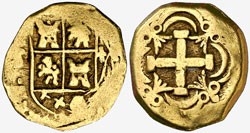
1722-1732 Philip V
doubloon Bogota mint
Size and shape were immaterial, which means that most cobs are far from round or uniform in thickness. The irregular shape invited clipping, and it was usually below legal weight. Cobs however were generally accepted as good currency all around the world and were the exact coins pirates referred to as "pieces of eight" (8 reales) and "doubloons", meaning double (any gold cobs but originally 2 escudos).
An illegal debasement of the cob coinage in the Viceroyalty of Peru in 1631-1648 was a major scandal. The public began refusing all Peruvian coins as potentially below the weight standard. After this affair, the shield design was replaced at all the Peruvian mints by a new pillar-and-wave design. The reputation of coins from the Mexico City mint was unblemished and shield type cobs continued to be produced there until 1734. Meanwhile, all Peruvian coins circulating in Spain were called to the mints in 1650 to be melted down and reminted.
In 1492 Christopher Columbus commanded the first Spanish exploratory voyage across the Atlantic Ocean, leading to Europe's eventual colonial engagement with the Americas. The newly discovered Western Hemisphere thereby became the focus of the Spanish crown. During the Age of Discovery, Spain began to settle the Caribbean islands and conquistadors soon toppled native empires, such as the Aztecs and Incas on mainland America. Later expeditions established an empire that stretched from present-day Canada in North America to the Falklands in South America. Immense treasure was soon discovered in central and South America that the Spanish quickly began to exploit.
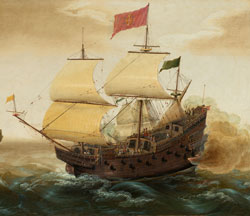 The Spanish treasure fleets were a convoy system adopted by the Spanish Empire from 1566 to 1790. The convoys were general purpose fleets used for transporting a wide variety of items, including agricultural goods and sometimes even lumber, manufactures and various metal resources and luxuries, most famously silver and gold, but also gems, pearls, spices, sugar, tobacco, silk, and other exotic goods from the Spanish colonies to Spain. Manufactures such as tools and other everyday items as well as Spanish emigrants were transported in the opposite direction to the New World.
The Spanish treasure fleets were a convoy system adopted by the Spanish Empire from 1566 to 1790. The convoys were general purpose fleets used for transporting a wide variety of items, including agricultural goods and sometimes even lumber, manufactures and various metal resources and luxuries, most famously silver and gold, but also gems, pearls, spices, sugar, tobacco, silk, and other exotic goods from the Spanish colonies to Spain. Manufactures such as tools and other everyday items as well as Spanish emigrants were transported in the opposite direction to the New World.
Spanish ships had brought treasure from the New World since Christopher Columbus's first expedition of 1492. The government started the convoy system in response to attacks by French pirates. The treasure fleets sailed along two sea lanes. The main one was the Spanish Caribbean fleet or Flota de Indias, which departed in two convoys from Seville, bound for ports such as Veracruz, Portobelo and Cartagena before making a rendezvous at Havana in order to return together to Spain. Vast quantities of silver treasure was brought up from the mines in Potosi, Peru and transported by ships up the Pacific coast to Panama. From there the treasure was carried by mules across the Isthmus of Panama to Portobelo. A secondary route was that of the Manila Galleons or Galeón de Manila which linked the Philippines to Acapulco. From Acapulco, the Asian goods were transhipped to Veracruz to be loaded on to the Caribbean treasure fleet for shipment to Spain. This made the returning Spanish treasure fleet a tempting target, although pirates were more likely to shadow the fleet to attack stragglers than try and seize the well-guarded main vessels.
Spain strictly controlled the trade and by law, the colonies could trade only with the one designated port in the mother country. Shipwreck salvaging has shown that the quantity of goods transported was usually much higher than that recorded at the Spanish archives in Seville. Spanish merchants resorted to contraband to transport their cargoes untaxed. The Crown of Spain taxed the wares and precious metals of private merchants at a rate of 20%, a tax known as the royal fifth. Spain became the richest country in Europe by the end of the 16th century, but the Habsburgs used the wealth to fight wars in the 16th and 17th centuries against the Muslim Ottoman Empire and with most of the other major European powers. Due to inflation in the 17th century, the flow of precious metals from the Indies gradually damaged and depressed the Spanish economy. Spain also lost any financial support from Europeans bankers by 1690. Nonetheless, the Spanish monopoly over its West Indies colonies lasted for over two centuries.
The exports' economic importance also declined with the drop of production of the American precious metals mines, such as Potosí. Numbering just 17 ships in 1550, the fleets expanded to more than 50 much larger vessels by the end of the century. By the second half of the 17th century, that number had dwindled less than half of its peak, with many of its remaining ships old and in poor repair. As economic conditions gradually recovered from the last decades of the 17th century, the fleet operations slowly expanded again, once again becoming prominent during the reign of the Bourbons in the 18th century. The Spanish trade of goods and precious metals was threatened until the mid-18th century by Spain's colonial rivals who seized small bases along the Spanish Main. English acquired small islands like St Kitts in 1624 and seized Jamaica in 1655, the French Saint-Domingue in 1625 and the Dutch Curaçao in 1634.
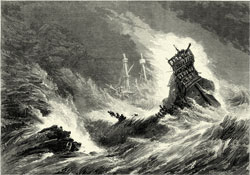 Despite the general perception that many Spanish galleons were captured by English or Dutch privateers, few fleets were actually lost to enemies in the course of the flota's long career. Only Piet Hein managed to capture the fleet in 1628 and bring the whole cargo safely to the Dutch Republic. In 1656 and 1657, Robert Blake destroyed the fleet, but the Spaniards saved most of the silver on board and the English admiral only managed to capture one galleon. The 1702 treasure fleet was destroyed in the Battle of Vigo Bay when surprised at port, but the Spanish sailors had already unloaded most of its cargo. None of these attacks took place in open seas. The vast majority of Spanish treasure lost at sea was due to nature and the violent storms that claimed many lost treasure galleons.
Despite the general perception that many Spanish galleons were captured by English or Dutch privateers, few fleets were actually lost to enemies in the course of the flota's long career. Only Piet Hein managed to capture the fleet in 1628 and bring the whole cargo safely to the Dutch Republic. In 1656 and 1657, Robert Blake destroyed the fleet, but the Spaniards saved most of the silver on board and the English admiral only managed to capture one galleon. The 1702 treasure fleet was destroyed in the Battle of Vigo Bay when surprised at port, but the Spanish sailors had already unloaded most of its cargo. None of these attacks took place in open seas. The vast majority of Spanish treasure lost at sea was due to nature and the violent storms that claimed many lost treasure galleons.
The era of piracy in the Caribbean Sea began in the 16th century and died out in the 1720s after navies of the nations of Western Europe, along with colonies in the Caribbean, began combating pirates. The period during which pirates were most successful was from the 1690s until the 1720s. Piracy flourished here because of the existence of relatively lawless British seaports, such as Port Royal in Jamaica and the French settlement at Tortuga.
Piracy in the Caribbean resulted from groups of Europeans, mostly English, Dutch and French, who were marooned or shipwrecked off the coast of Hispaniola. They were called buccaneers as well, from the French "boucaner" (to smoke meat) on a "boucan" (wooden frame set over a fire). They had to be skilled at boat construction, sailing and hunting. By setting up smokey fires and boucans with prepared meat of marooned cattle, these castaways could get a ship to draw near for trading, at which time the buccaneers could seize the ship. The buccaneers were later chased off the island by colonial powers and had to seek a life at sea. There they created lucrative but illegitimate opportunities for common seamen to attack European merchant ships (especially Spanish fleets sailing from the Caribbean to Europe) and seize their valuable cargo, a practice that began in the 16th century. Piracy was sometimes given "legal" status by colonial powers in the hopes of weakening the sea trade of their rivals. This "legal" form of piracy was known as privateering.
From 1520 to 1560, French privateers were alone in their fight against the Crown of Spain and the vast commerce of the Spanish Empire in the New World. They were later joined by English and Dutch privateers. The following quote by a Welsh pirate shows the motivations for piracy in the 18th century Caribbean: "In an honest service, there is thin commons, low wages, and hard labour; in this, plenty and satiety, pleasure and ease, liberty and power; and who would not balance creditor on this side, when all the hazard that is run for it, at worst, is only a sower look or two at choaking. No, a merry life and a short one shall be my motto", pirate Captain Bartholomew Roberts.
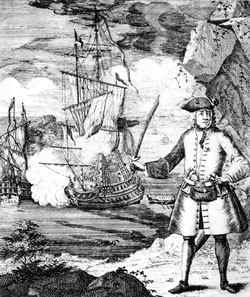 In the Caribbean, the use of privateers became increasingly popular. The cost of maintaining a fleet to defend the colonies was beyond national governments of the 16th and 17th centuries. Private vessels would be commissioned into a "navy" with a letter of marque, paid with a substantial share of whatever they could capture from enemy ships and settlements, with the rest going to the crown. These ships would operate independently or as a fleet, and if successful, the rewards could be great. When Jean Fleury and his men captured Cortes' vessels in 1523, they found the incredible Aztec treasure that they were allowed to keep. Later, when Francis Drake captured the Spanish Silver Train at Nombre de Dios (Panama's Caribbean port at the time) in 1573, his crews were rich for life. This was repeated by Piet Hein in 1628, who made a profit of 12 million guilders for the Dutch West India Company. This substantial profit made privateering something of a regular line of business; wealthy businessmen or nobles would be quite willing to finance this legitimized piracy in return for a share. The sale of captured goods was a boost to colonial economies as well.
In the Caribbean, the use of privateers became increasingly popular. The cost of maintaining a fleet to defend the colonies was beyond national governments of the 16th and 17th centuries. Private vessels would be commissioned into a "navy" with a letter of marque, paid with a substantial share of whatever they could capture from enemy ships and settlements, with the rest going to the crown. These ships would operate independently or as a fleet, and if successful, the rewards could be great. When Jean Fleury and his men captured Cortes' vessels in 1523, they found the incredible Aztec treasure that they were allowed to keep. Later, when Francis Drake captured the Spanish Silver Train at Nombre de Dios (Panama's Caribbean port at the time) in 1573, his crews were rich for life. This was repeated by Piet Hein in 1628, who made a profit of 12 million guilders for the Dutch West India Company. This substantial profit made privateering something of a regular line of business; wealthy businessmen or nobles would be quite willing to finance this legitimized piracy in return for a share. The sale of captured goods was a boost to colonial economies as well.
Traditionally, buccaneer crews operated as a democracy. The captain was elected by the crew and they could vote to replace him. The captain had to be a leader and a fighter, for when in combat, he was expected to be fighting with his men, not directing operations from a distance. Spoils were evenly divided into shares and when the officers had a greater number of shares, it was because they took greater risks or had special skills. Often the crews would sail without wages, "on account" and the spoils would be built up over a course of months before being divided. There was a strong esprit de corps among pirates. This allowed them to win sea battles by typically outmanning trade vessels by a large ratio. There was also, for some time, a social insurance system, guaranteeing money or gold for battle wounds at a worked-out scale. The romantic notion of pirates burying treasure and wearing gaudy clothes had some basis in fact. However, most pirate wealth was accumulated by the selling of chandlery items such as ropes, sails, block and tackle, stripped from captured ships.
One undemocratic aspect of the buccaneers was that sometimes they would force specialists like carpenters or surgeons to sail with them for some time, though they were released when no longer needed (if they had not volunteered to join by that time). Note also that a typical poor man had few other promising career choices at the time apart from joining the pirates. According to reputation, the pirates' egalitarianism led them to liberate slaves when taking over slave ships. However, there are several accounts of pirates selling slaves captured on slave ships, sometimes after they had helped man the pirates' own vessels. In combat, they were considered ferocious and were reputed to be experts with flintlock weapons, but these were so unreliable that they were not in widespread military use before the 1670s.
In the 1620s, a new English venture on Providence Island off the malaria ridden Mosquito Coast of Nicaragua, deep in the heart of the Spanish Empire, had become the premier base for English privateers and other pirates raiding the Spanish Main. The Spanish Empire's colonies were badly neglected from the middle of the 17th century because of Spain's many woes. Freebooters and privateers, experienced after decades of European warfare, pillaged and plundered the almost defenseless Spanish settlements with ease and little interference from the European governments back home who were too worried about their own problems to turn much attention to their New World colonies. The non-Spanish colonies were growing and expanding across the Caribbean, fueled by a great increase in immigration as people fled from the chaos and lack of economic opportunity in Europe. While most of these new immigrants settled into the West Indies' expanding plantation economy, others took to the life of the pirate.
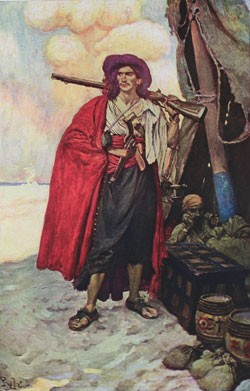 The 1670s to 1720 are often considered the "Golden Age of Piracy" in the Caribbean. The military power of the Spanish Empire in the New World started to decline while Spanish America in the late 17th century had little military protection. Spain entered a phase of decline as a great power, however the Spanish territories in the New World suffered less from the Spanish Crown's overbearing policies with its economy. This lack of interference, combined with a surge in output from the silver mines, began resurgence in the fortunes of Spanish America. By the late 17th century, the great Spanish towns of the Caribbean had begun to prosper, but remained poorly defended militarily because of Spain's problems and so were sometimes easy prey for pirates and privateers.
The 1670s to 1720 are often considered the "Golden Age of Piracy" in the Caribbean. The military power of the Spanish Empire in the New World started to decline while Spanish America in the late 17th century had little military protection. Spain entered a phase of decline as a great power, however the Spanish territories in the New World suffered less from the Spanish Crown's overbearing policies with its economy. This lack of interference, combined with a surge in output from the silver mines, began resurgence in the fortunes of Spanish America. By the late 17th century, the great Spanish towns of the Caribbean had begun to prosper, but remained poorly defended militarily because of Spain's problems and so were sometimes easy prey for pirates and privateers.
England, France and the Dutch Netherlands had all become New World colonial powerhouses in their own right by 1660. However, Europe was consumed in the final decades of the 17th century by warfare and it was an opportune time for pirates and privateers to engage in their bloody trade. In the Caribbean, this political environment led colonial governors to new threats from every direction. The Dutch sugar island of Saint Eustatius changed ownership ten times between 1664 and 1674 as the English and Dutch dueled for supremacy. Consumed with the various wars in Europe, the mother countries provided few further military reinforcements to their colonies, so the colonial governors of the Caribbean increasingly made use of buccaneers as mercenaries and privateers to guard their colonies or carry the fight to their mother country's current enemy. Surprisingly (or not), these undisciplined and greedy dogs of war often proved difficult for their sponsors to control. Captured from Spain in 1655, the island of Jamaica had been taken over by England and its chief settlement of Port Royal had become a new English buccaneer haven in the midst of the Spanish Empire. The French also maintained their privateering stronghold around western Hispaniola, at their traditional pirate port of Tortuga.
By 1700 the European states had enough troops and ships at their disposal to begin better protecting the important colonies in the West Indies and in the Americas without relying on the aid of privateers. This spelled the doom of privateering and the easy life it provided for the buccaneer. Though Spain remained a weak power for the rest of the colonial period, pirates in large numbers generally disappeared after 1720, chased from the seas by a new English Royal Navy squadron based at Port Royal, Jamaica. Economically, the late 17th century and the early 18th century was a time of growing wealth and trade for all the nations of the Caribbean. Although some piracy would always remain until the mid-eighteenth century, the path to wealth in the Caribbean in the future lay through peaceful trade, the growing of tobacco, rice, sugar and smuggling. After 1720, piracy in the classic sense became extremely rare in the Caribbean as European military and naval forces, especially those of the Royal Navy, just became too widespread and active for any pirate to pursue an effective career for long. Pirates who were caught were usually hanged as soon as the British returned to port.
The famous pirates of the early 18th century were a completely illegal remnant of a golden buccaneering age, and their choices were limited to quick retirement or eventual capture. Contrast this with the earlier example of Henry Morgan, who for his privateering efforts was knighted by the English Crown and appointed the governor of Jamaica.
In the early 19th century, piracy along the East and Gulf Coasts of North America as well as in the Caribbean increased again. Jean Lafitte was probably the greatest pirate of the time, operating in the Caribbean and in American waters from his havens in Texas and Louisiana during the 1810s.
Jean Fleury - Born in Vatteville and financed by shipowner Jean Ango, french privateer Jean Fleury was Spain's nightmare. In 1522, he captured seven Spanish vessels. One year later, Montezuma's Aztec treasure fell into his hands after he caught Cortez's fleet. He was captured in 1527 and executed by order of Spanish King Charles I.
François Le Clerc - also nicknamed "Jambe de bois" ("Pie de Palo", "wooden leg") was a formidable privateer, ennobled by Henri II in 1551. In 1552, Le Clerc ransacked Porto Santo. One year later, he gathered one thousand men and caused havoc in the Caribbean with his lieutenants, Jacques Sores and Robert Blondel. They pillaged and burned down the seaports of Santo Domingo. He ransacked Las Palmas on his way back to France. He led another expedition in 1554 and devastated Santiago de Cuba.
Blackbeard - Perhaps the most famed pirate from this period was known as "Blackbeard." He was born about 1680 in England as Edward Thatch, Teach, or Drummond, and operated off the east coast of North America in the period of 1714-1718. Noted as much for his outlandish appearance as for his piratical success. In combat, Blackbeard placed burning slow-match (a type of slow-burning fuse used to set off cannon) under his hat. With his face wreathed in fire and smoke, his victims claimed he resembled a fiendish apparition from Hell. Blackbeard's ship was the two hundred ton, forty-gun frigate he named, Queen Anne's Revenge. Blackbeard met his end at the hands of a British fleet specifically sent out to capture him off the coast of North Carolina. After an extremely bloody boarding action, the British commanding officer of the fleet, Lieutenant Robert Maynard, killed him with the help of his crew. According to legend, Blackbeard suffered a total of five bullet wounds and twenty slashes with a cutlass before he finally died in 1718.
Henry Morgan - a Welshman, he was one of the most destructive pirate captains of the 17th century. Although Morgan always considered himself a privateer rather than a pirate, several of his attacks had no real legal justification and are considered piracy. A bold, ruthless and daring man, Morgan fought England's enemies for thirty years, and became a very wealthy man in the course of his adventures. Morgan's most famous exploit came in late 1670 when he led 1,700 buccaneers up the pestilential Chagres River and then through the Central American jungle to attack and capture the "impregnable" city of Panama. Morgan's men burnt the city to the ground, and the inhabitants were either killed or forced to flee. Although the burning of Panama City did not mean any great financial gain for Morgan, it was a deep blow to Spanish power and pride in the Caribbean and Morgan became the hero of the hour in England. At the height of his career, Morgan had been made a titled nobleman by the English Crown and lived on an enormous sugar plantation in Jamaica. Morgan died in his bed, rich and respected, something rarely achieved by pirates in his day or any other.
Bartholomew Sharp - was an English buccaneer whose pirate career lasted only three years, from 1679-1682. Sharp's career as a pirate captain began when the buccaneers, with whom he was sailing round South America, needed a new commander. He quickly proved himself a natural leader and a capable seaman, however, these qualities did not prevent him being deposed as captain in January 1681, after storms and setbacks provoked a mutiny. His successor was killed three weeks later and Sharp resumed command of his flagship, the Trinidad. Under him, the buccaneers continued around South America and up to the Caribbean, taking 25 Spanish ships and plundering numerous Spanish towns. Bartholomew Sharp is credited as being the first Englishman ever to travel eastwards around Cape Horn. Sharp had planned to return to England via the Strait of Magellan, but a storm pushed the Trinidad too far south forcing him to navigate the Cape. Because England and Spain were not at war, the Spaniards demanded Sharp's prosecution for piracy. Sharp however, presented the authorities with a book of maps taken from the Spanish ship El Santo Rosario in July 1681; their value to English seafarers was such that Sharp received a full pardon from Charles II.
Bartholomew Roberts - Less famous than Blackbeard, Bartholomew Roberts was far more successful, sinking or capturing and pillaging some 459 ships. He started his freebooting career in the Gulf of Guinea in February 1719 when Howell Davis' pirates captured his ship and he proceeded to join them. Rising to captain, he quickly came to the Caribbean and plagued the area until 1722. He commanded a number of large, powerfully armed ships, all of which he named Fortune, Good Fortune or Royal Fortune. Efforts by the governors of Barbados and Martinique to capture him only provoked his anger. When he found the governor of Martinique aboard a newly captured vessel, Roberts hanged the man from a yardarm. Roberts returned to Africa in February 1722, where he met his death in a naval battle, whereby his crew was captured.
Stede Bonnet - Probably the least qualified pirate captain ever to sail the Caribbean, Bonnet, was a sugar planter who knew nothing about sailing. He started his piracies in 1717 by buying an armed sloop on Barbados and recruiting a pirate crew for wages, possibly to escape from his wife. He lost his command to Blackbeard and sailed with him for some time as a guest or prisoner. Although Bonnet briefly regained his captaincy, he was captured and hanged before he could return to the West Indies.
Charles Vane - Charles Vane, like many early 18th century pirates, operated out of Nassau in the Bahamas. He was the only pirate captain to resist Woodes Rogers when Rogers asserted his governorship over Nassau in 1718, attacking Rogers' squadron with a fire ship and shooting his way out of the harbor rather than accept the new governor's royal pardon. Vane's quartermaster was Calico Jack Rackham, who deposed Vane from the captaincy. Vane started a new pirate crew, but he was captured and hanged in Jamaica in 1720.
Edward Low - Low was notorious as one of the most brutal and vicious pirates. Originally from London, he started as a lieutenant to George Lowther, before striking out on his own. His career as a pirate lasted just three years, during which he captured over 100 ships, and he and his crew murdered, tortured and maimed hundreds of people. After his own crew mutinied in 1724, when Low murdered a sleeping subordinate, he was rescued by a French vessel who hanged him on Martinique.
Anne Bonny and Mary Read - were undoubtedly the most famous pirates never to hold the position of captain. Both spent their brief sea-roving careers under the command of Calico Jack Rackham. They are noted chiefly for their gender, highly unusual for pirates, which helped to sensationalize their 1720 trial in Jamaica. They gained further notoriety for their ruthlessness. They are known to have spoken in favor of murdering witnesses in the crew's counsels and for having resisted far more fiercely than their male crewmates when Rackham's ship was taken. The capstone to their legend is that they alone, out of all Rackham's crew, escaped execution, as both were newly pregnant at their trial and their sentences were commuted to avoid harm to their unborn children.